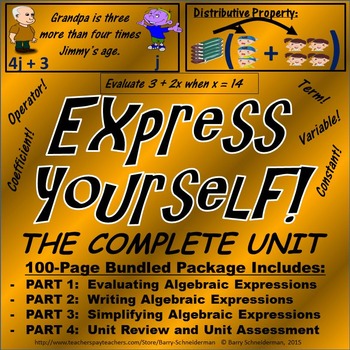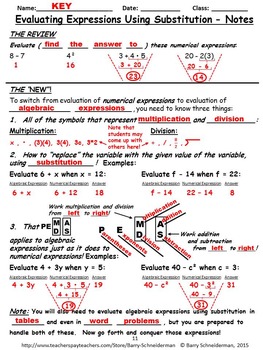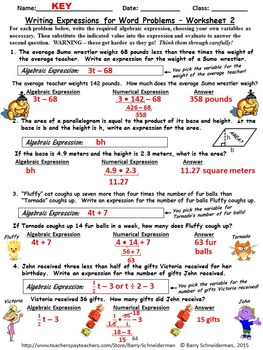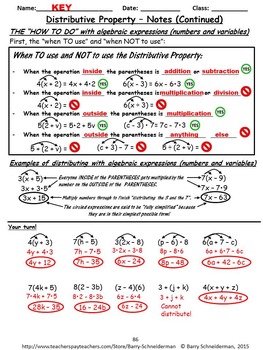Simplifying, Evaluating, Writing Algebraic Expressions Unit
- PDF
What educators are saying
Description
Algebraic expressions – a key stepping stone toward a complete understanding of and appreciation for algebra. What delineates an algebraic expression from a numerical expression or from an algebraic equation? Why would we choose to use an expression with one or more variables in it when we could just fall back on those reliable expressions with plain old numbers that we have used for the first several years of our schooling? Where are some key areas (areas of geometric figures, temperature, science formulas, etc.) where we may already be using algebraic expressions without being aware of it? How and why do we use algebraic expressions to evaluate problems? How do we write expressions for word problems? What numerical properties help us to write them? How can we make expressions simpler and easier to use? All of these questions are key to establishing not only a student’s understanding of algebra, but also his or her buy-in to algebraic concepts and desire to learn more. Establishing a foundation with algebraic expressions can mean the difference between, “I get it! This stuff is cool!” and, “Get these letters away from me. Math is about numbers!”
This product, then, consists for four separate sections (each can also be purchased separately) which attempt to address the questions above:
Express Yourself - Part 1: Evaluating Expressions: This section focuses on what algebraic expressions are, why we use them, how they are different from numerical expressions and algebraic equations, and how to evaluate expressions of varying levels of complexity when given values for the variables. This part of the product consists of a warm-up activity, two pages of guided notes on evaluating expressions, the ever-popular Algebraic Expression Cheer, and then four different worksheets of increasing level of difficulty.
Express Yourself - Part 2: Writing Expressions: This section takes the students one step further by switching the focus to how to write and use algebraic expressions from word phrases and then to solve word problems using the expressions. This part of the product consists of warm-up activities, guided notes pages, and worksheets and puzzles on how to apply properties of numbers to expressions, how to write expressions from word phrases, and how to write and evaluate appropriate expressions for word problems. It concludes with two pictorially-illustrated, entertaining, and challenging word problem worksheets.
Express Yourself - Part 3: Simplifying Expressions: This section focuses on simplifying expressions, manipulating variables algebraically using various number properties including the distributive property. This part of the product consists of warm-up activities, guided notes pages, and worksheets, first regarding expression terminology and combining like terms, then regarding the Distributive Property, and then regarding expressions which take multiple steps to simplify.
Express Yourself - Part 4: Review and Unit Test: This section contains a comprehensive review and unit assessment for the concepts learned and taught in the first three sections. A thorough conclusion to an all-encompassing unit! Note that the review can also be used as a pre-test.
Feel free to review the preview file for details on all parts of this product.
Good luck in your use of Express Yourself – The Complete Unit!
Related Products:
If your students are not familiar with how to execute operations in the correct order, you may want to go through part or all of Order of Operations Inundation to address numerical expressions and PEMDAS prior to tackling algebraic expressions.
If you would like your students to move from algebraic expressions to algebraic equations, take a look at Equations With Ned, a unit which introduces students to ONE-STEP EQUATIONS in a unique and exciting way, and Equations With Ned – Complete One and Two-Step Equations Unit, a complete three-week unit on solving BOTH ONE AND TWO-STEP EQUATIONS.
Feel free to also check out a growing number of other products that use poetry, songs, games, worksheets, and assessments to make math fun and help students to learn a variety of common core math standards.
Click here to view Algebraic Expression and Equation Products
Click here to view Data, Statistics, and Probability Products
Click here to view Decimal Products
Click here to view Divisibility Rule Products
Click here to view Elementary to Middle School Transition Products
Click here to view Factor / Multiple Products
Click here to view Fraction Products
Click here to view Geometry Products
Click here to view Integer, Rational Number, and Order of Operations Products
Click here to view Ratio-Rate-Proportion-Percent Products
Click here to view Riddle Card Products that Help Retain Math Essentials
Customer Tips:
How to get TPT credit to use on future purchases:
• Please go to your My Purchases page (you may need to login). Beside each purchase you'll see a Provide Feedback button. Simply click it and you will be taken to a page where you can give a quick rating and leave a short comment for the product. Each time you give feedback on a purchased product, TPT gives you feedback credits that you use to lower the cost of your future purchases. I value your feedback greatly as it helps me determine which products are most valuable for your classroom so I can create more for you.
Be the first to know about my new discounts, freebies and product launches:
• Look for the green star next to my store logo and click it to become a follower. Voila! You will now receive email updates about this store.
Terms of Use:
Copyright © Barry Schneiderman. This product is to be used by ONE teacher (the purchaser) for his or her classes only. Any reproduction of this material is limited to the purchaser for his or her classes. Beyond this usage, it may not be reproduced, republished, or copied in any way without written permission of the publisher. It may not be distributed to other teachers, a school department, a school, or a school district. This product may not be posted on any website, including but not limited to classroom websites, school websites, or district websites, without written permission of the publisher. Failure to follow the terms of usage represents a copyright violation per the Digital Millennium Copyright Act (DMCA). To receive written permission to copy or post this product beyond the terms of use, ask Barry Schneiderman a question on Teachers Pay Teachers.





